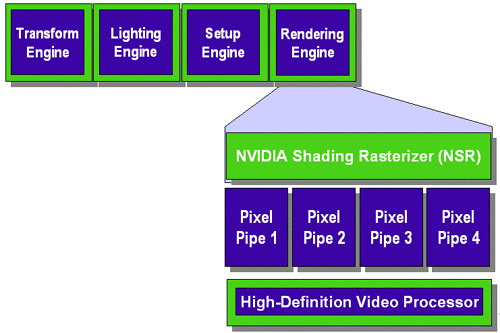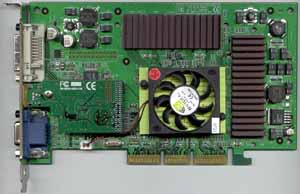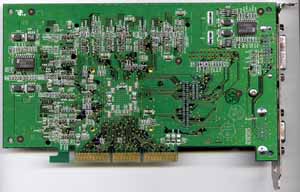The architecture of the GeForce2 Ultra is identical to that of the GeForce2 GTS. It features the same four rendering pipelines and the ability to process two textures per pipeline per clock.

The only difference that
exists is that the GeForce2 Ultra uses an “advanced” 0.18-micron process allowing
it to reach a higher operating clock speed. The GeForce2 GTS runs at 200MHz
by default, and the average GeForce2 GTS can overclock to  approximately
238MHz with the best of the best able to hit 250MHz.
approximately
238MHz with the best of the best able to hit 250MHz.
The GeForce2 Ultra ships, by default, at 250MHz, which proves one of two things: NVIDIA either 1) did improve the 0.18-micron process thus allowing for higher clock speeds to be obtained (since we could overclock far beyond 250MHz as well) or 2) they are simply hand-picking the chips that can hit the higher core clocks.
The latter seems to be true, as it would make the most sense for them; it is also what they did with the original TNT2 Ultra in comparison to the TNT2. The parts that made it to the higher core clock were marked as Ultra parts and those that didn’t were simply regular TNT2s. This is most likely the case with the GeForce2 GTS and the GeForce2 Ultra: the higher clocked Ultras are probably the higher yielding GeForce2 chips.
At 250MHz, the GeForce2 Ultra has a pixel fill rate of 1000 Megapixels per second, or 1 Gigapixel/s; this is a 25% increase in pixel fill rate over the GeForce2 GTS. And since the GeForce2 Ultra, like its predecessor, can process two textures per clock, the Ultra has a texel fill rate of 2000 Megatexels/s or 2 Gigatexels/s. This is a very impressive amount of fill rate, which is even greater than that of the unreleased Voodoo5 6000 (1.33 Gigapixels/Gigatexels per second), but as you’ll remember from our GeForce2 GTS review, the biggest problem for the chip isn’t fill rate, but memory bandwidth.
Unlike the GeForce2 GTS, which could be outfitted with either 32MB or 64MB of DDR SGRAM/SDRAM, the GeForce2 Ultra will only be available as a 64MB card. While the chip supports up to 128MB of memory, it is unlikely that we will see a 128MB configuration this year; if need be, there is always the possibility that we will see boards with more memory as time goes on and as memory prices (hopefully) drop.
NVIDIA attempted to lessen the chip’s memory bandwidth bottleneck by using faster memory and pumping up the memory clock from 166MHz DDR (effectively 333MHz) to 230MHz DDR, yielding an effective 460MHz memory clock. This is a hefty increase over the original GeForce2 GTS, and the 39% increase in actual memory clock speed results in an incredible 7.36GB/s of peak available memory bandwidth. The only card that could possibly offer more memory bandwidth will be the Voodoo5 6000, which should have twice the available memory bandwidth of the 5500 (5.3GB/s). However, since the 6000 will be a quad chip solution, that massive amount of memory bandwidth will be cut into by the texture duplication that is necessary for all four chips.
Because of the increase in memory bandwidth, the biggest advantage the GeForce2 Ultra will have over the GeForce2 GTS is at higher resolutions, in 32-bit color modes especially. This is a very brute force method of achieving higher frame rates (unlike ATI’s HyperZ technology, which has more finesse), but it does get the job done. The big question is, at what cost?












0 Comments
View All Comments